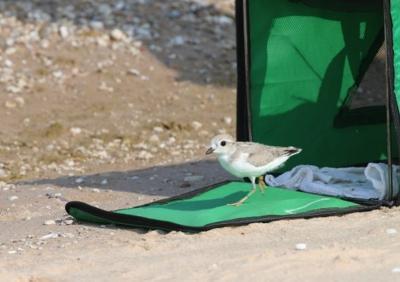While piping plovers were once abundant along Great Lakes shorelines, habitat loss, human disturbance, and predators caused their numbers to dwindle. The species was listed as federally endangered in 1986 and by the 1990s, only 12 pairs remained. However, thanks to the work of numerous federal and state agencies, non-governmental organizations, and other partners, a record 85 nesting pairs can be found today.
Recovery efforts have been underway for nearly 40 years, but extra funding and resources from the Great Lakes Restoration Initiative have allowed established recovery efforts to flourish and enabled partners to uncover new methods to help these small shorebirds. Since 2010, the GLRI has funded piping plover recovery efforts like captive rearing, nest monitoring, and habitat restoration.
Each season, the GLRI supports work to locate and identify each piping plover pair and nest, put protections around the nests, and monitor each for the full breeding season. Through this dedicated effort, monitors can increase nest success, quickly identify abandoned nests if they fail, and then rescue eggs that can be raised in captivity to help supplement the population. Every piping plover is also banded, which has increased our knowledge of the species and improved management outcomes.
Piping plovers are now a media sensation serving as a beloved mascot for Great Lakes communities. Local enthusiasts flock to beaches to observe fledglings and continue to advocate for the species’ comeback.
Last year marked a major milestone when 81 pairs were found throughout the basin. With this record being broken again in 2025, partners are hopeful that they will one day meet the goal of 150 nesting pairs.
In the U.S., researchers, partners and volunteers work together to protect this endangered shorebird. Long-term partnerships that have contributed to this milestone in species recovery in the U.S. include the Chicago Park District, Chicago Piping Plovers volunteer monitors, Illinois DNR, Detroit Zoo, University of Minnesota, National Park Service, US Fish and Wildlife Service, US Forest Service, USDA Wildlife Services, Lake Superior State University, State University of Natural Resources ESF, Wisconsin DNR, Michigan DNR, Pennsylvania Game Commission and Department of Conservation and Natural Resources, Ohio DNR, New York State Department of Environmental Conservation, University of Michigan Biological Station, Great Lakes Tribes, Lincoln Park Zoo, Rosamond Gifford Zoo, Toledo Zoo, The Nature Conservancy, UP Land Conservancy, St. Louis River Alliance Audubon Society, Black Swamp Bird Observatory, Huron Pines, and all of the many volunteers throughout the Great Lakes.


